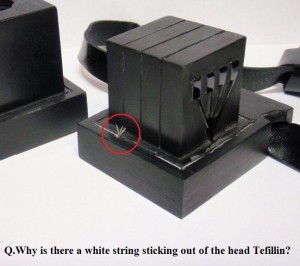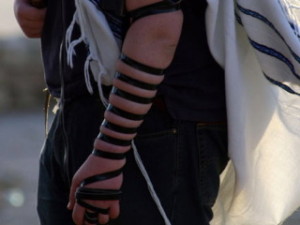|
Yes it does, however as far as a Brachah/Blessing is concerned it depends on the location of the garage. If it is adjoining or part of the house, such that one can exit the car and walk through a door into the house without leaving the garage all agree a Brachah/Blessing is recited. If however the garage is not adjoining or part of the house nor encircled by a gate that encompasses both it and the house it is a matter of dispute and therefore a Brachah should not be recited.
0 Comments
The reason is to demonstrate our love for this Mitzvah.
There is a source to this custom in the Talmud regarding the conversion of the Roman Caesar’s men (Avodah Zarah 11b). Onkelos the son of Klonimus converted to Judaism. The Caesar, his uncle sent a legion of Roman soldiers to retrieve him. However, he enticed them to Judaism by quoting verses, and they converted to Judaism.The Caesar sent a new legion but this time he instructed them not to enter into conversation with his nephew. As they dragged him from his home, Onkelos saw the Mezuzah affixed to his doorpost. He placed his hand upon it to kiss it and asked them, “Do you know what this is?” The soldiers could not contain their curiosity and answered, “You tell us” Onkelos explained to them, “It is the custom of the world that the king sits in the inside of the palace, and the guards protect him from the outside. However, with G‑d, His servants are inside their homes and He protects them from the outside, as the verse says (Psalms 121:8), “G‑d will protect your departure and your arrival from now and forever. They were inspired and they too converted to Judaism. After that, the Caesar ceased sending soldiers to bring him back. A right-handed person should use his right hand and a left-handed person should use their left hand. It is permitted to kiss the Mezuzah even before one has washed his or her hands in the Morning since the Mezuzah is covered in a case. If a Mezuzah has fallen down on to the ground and it is still in its case one should give charity. If it is not in its case (if the case breaks from the fall or it falls while it is being inserted into its case) it is questionable whether one is required to fast as in the case of Tefillin. In this case, one should as least give charity.
It is written in Seforim that if a Mezuzah falls down it is customary to have it checked before it is reaffixed. If one does not have plans to get the Mezuzah checked, it must be reaffixed immediately (even before putting on Tefillin or davening) with a Brachah if its a location that requires a Brachah. If however, it cannot be reaffixed immediately, for example if it falls off on Shabbos/Shabbat, you may continue to use the room. The Mezuzah should be picked up in an irregular manner, i.e. with a spoon and put aside in order to be put up right after Shabbos. Practically speaking, before you put it back up you should check that it was attached properly, such as with screws, nails or double-sided mounting tape. If it wasn’t make sure it is re-affixed properly.  Actually, it is not any ordinary string; it is hair from a kosher animal. It is a Halachah transmitted to Moshe at Sinai, that all of the Parshios (Tefillin text) need to be wrapped with hair of a kosher animal. It is customary to use the hair from the tail of a calf, and the reason it sticks out of the head Tefillin is so we will constantly see it and be reminded of the Cheit Haeigel (the sin of the golden calf). This will keep us humble and prevent us from coming to sin. The general custom is not to be too particular about how many hairs stick out of the head Tefillin, though it is preferred to have at least two. If the hairs were never pulled out or they were but slipped back inside, the Tefillin are still kosher bedieved (when you have no other Tefillin and have no local Sofer to bring it and get it fixed). Therefore, it would be important to take care of it as soon as possible.  No, there may be no separation between the body and the Tefillin batim/boxes or the Retzuah/Teffilin straps that encircles the head or the upper arm which hods the Hand Tefillin box in place. Preferably there should not be any separation between the body and the rest of the Tefillin strap as well. This includes, shirt sleeves, watches or a Kipa, if one wears a toupee it must be removed before putting on Tefillin. If medically necessary it is permitted to wear a medicinal patch or bandage under the Rezuah Shel Yad/Hand Tefillin Strap. If medically necessary it is permitted to wear a medicinal patch or bandage under the Rezuah Shel Yad/Hand Tefillin Strap. Someone who, G-d forbid, broke their arm continues to place Tefillin on the broken arm (the Halachic authorities only have a doubt if the arm is permanently paralyzed). If the cast is only on the arm and not on the bicep, then one makes a Bracha/Blessing and puts the Tefillin on the bicep and wraps the strap over the cast. If the cast covers the bicep the Tefillin is placed on the bicep (and wrapped around the arm) but without a Brachah. Even in such a case a Brachah must be made on the head Tefillin. There should be no writing on the underside of the Straps. Some Rabbis consider long bangs to be a separation between the Tefillin and the head. A person should also take in to consideration that it is hard to keep the Tefillin in the correct place if it is resting on long thick locks of hair. The underside of the Retzuos must rest against the arm and the head. No part of the Retzuah/Tefillin Strap may be flipped over that the underside is visible. |
Categories
All
AuthorRabbi Kass was ordained by Rabbi Yisrael Meir Lau, former Ashkenazik Chief Rabbi of Israel. He is certified as a Sofer for both Kesivah and Hagoah by one of the leading experts in Safrus, Rabbi Avrohom Tzvi Vosner, Rav of the Vad Mishmeres Sta”m. Archives
March 2018
|
What our clients say about us: |
To enhance our service quality, we operate on an appointment-only basis.
Please contact us to make an appointment. $12.99 Flat rate shipping! Mezuzahs, Tefillin & Accessories! |
|






